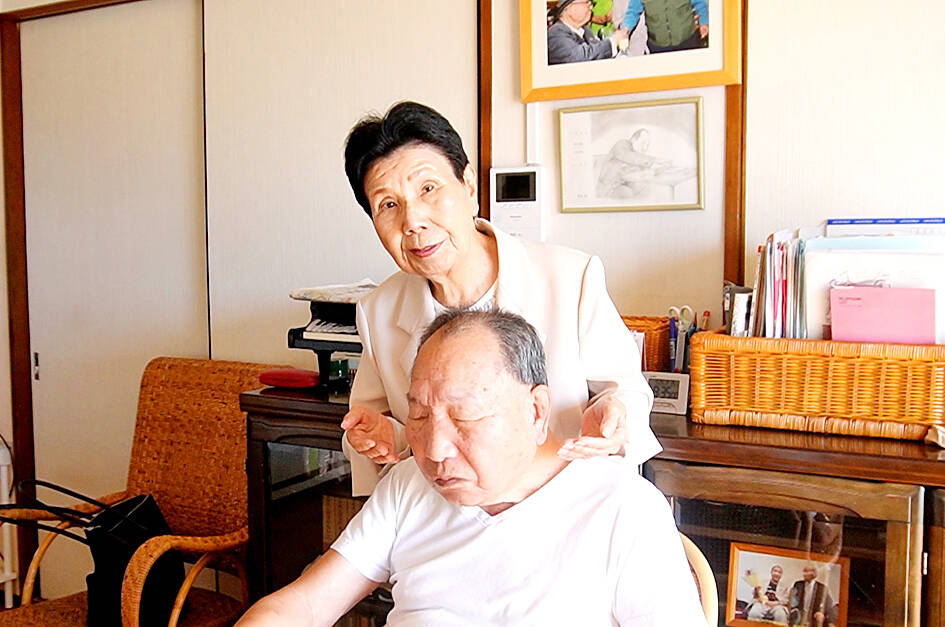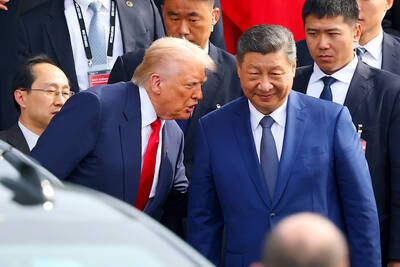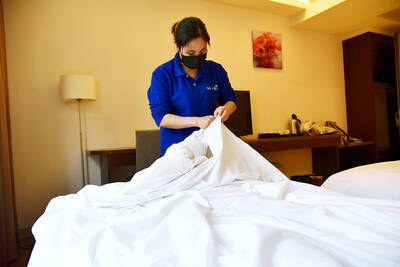A Japanese man who spent almost half a century on death row has been found not guilty of multiple murders, in a closely watched trial that has raised questions about Japan’s use of the death penalty.
Iwao Hakamada, 88, was sentenced to hang in 1968 after being found guilty of murdering his boss, his wife and their two teenage children, and setting fire to their home two years earlier.
The former professional boxer spent 46 years on death row — believed to be the longest time spent on death row of any prisoner worldwide — until he was freed in 2014 when new evidence emerged and a retrial was ordered.

Photo: EPA-EFE
Hakamada has consistently protested his innocence and said investigators forced him to confess, while his lawyers alleged police had fabricated evidence.
There was no immediate decision on whether prosecutors would appeal against the verdict, which was reported by Kyodo news agency and other Japanese media outlets. Hakamada’s defense lawyers have urged prosecutors not to challenge the ruling, given his age.
The presiding judge at Shizuoka District Court, Koshi Kunii, acknowledged that three pieces of evidence had been fabricated, including Hakamada’s “confession” and items of clothing that prosecutors claimed he had been wearing at the time of the murders.
His 91-year-old sister, Hideko Hakamada, who has campaigned tirelessly on behalf of her brother, told reporters before yesterday’s verdict: “For so long we have fought a battle that has felt endless. But this time, I believe it will be settled.”
Prosecutors had again demanded the death penalty, but legal experts had suggested Iwao Hakamada would be acquitted, pointing to four other retrials involving death row inmates in Japan who had their convictions overturned.
Iwao Hakamada, whose physical and mental health deteriorated during his long incarceration, was not present at yesterday’s ruling and has been represented by his sister during the retrial.
The outcome rested on the reliability of bloodstained clothes that prosecutors said Iwao Hakamada had been wearing at the time of the murder, at a miso factory in central Japan where he was a live-in employee.
When it ordered a retrial in March last year after years of legal wrangling, the Tokyo High Court said there was a strong possibility that the clothing had been planted in a tank of miso by investigators.
Defense lawyers said DNA tests on the clothes proved the blood was not Iwao Hakamada’s.
The high court had initially decided not to reopen Iwao Hakamada’s case — a cause celebre for opponents of capital punishment — but reversed its decision after the Japanese Supreme Court ordered it to reconsider in 2020.
Hundreds of people had lined up outside the district court yesterday in the hope of securing a seat in the public gallery, while supporters held up banners demanding Iwao Hakamada’s acquittal.
Campaigners said his ordeal had exposed flaws in Japan’s criminal justice system and the cruelty of capital punishment.
Death row inmates in Japan — one of only two G7 countries along with the US that retains the death penalty — are notified of their execution, by hanging, only hours in advance and given no opportunity to speak to their lawyers or families. Their final conversation is usually with a Buddhist priest.

CALL FOR SUPPORT: President William Lai called on lawmakers across party lines to ensure the livelihood of Taiwanese and that national security is protected President William Lai (賴清德) yesterday called for bipartisan support for Taiwan’s investment in self-defense capabilities at the christening and launch of two coast guard vessels at CSBC Corp, Taiwan’s (台灣國際造船) shipyard in Kaohsiung. The Taipei (台北) is the fourth and final ship of the Chiayi-class offshore patrol vessels, and the Siraya (西拉雅) is the Coast Guard Administration’s (CGA) first-ever ocean patrol vessel, the government said. The Taipei is the fourth and final ship of the Chiayi-class offshore patrol vessels with a displacement of about 4,000 tonnes, Lai said. This ship class was ordered as a result of former president Tsai Ing-wen’s (蔡英文) 2018

UKRAINE, NVIDIA: The US leader said the subject of Russia’s war had come up ‘very strongly,’ while Jenson Huang was hoping that the conversation was good Chinese President Xi Jinping (習近平) and US President Donald Trump had differing takes following their meeting in Busan, South Korea, yesterday. Xi said that the two sides should complete follow-up work as soon as possible to deliver tangible results that would provide “peace of mind” to China, the US and the rest of the world, while Trump hailed the “great success” of the talks. The two discussed trade, including a deal to reduce tariffs slapped on China for its role in the fentanyl trade, as well as cooperation in ending the war in Ukraine, among other issues, but they did not mention

HOTEL HIRING: An official said that hoteliers could begin hiring migrant workers next year, but must adhere to a rule requiring a NT$2,000 salary hike for Taiwanese The government is to allow the hospitality industry to recruit mid-level migrant workers for housekeeping and three other lines of work after the Executive Yuan yesterday approved a proposal by the Ministry of Labor. A shortage of workers at hotels and accommodation facilities was discussed at a meeting of the legislature’s Transportation Committee. A 2023 survey conducted by the Tourism Administration found that Taiwan’s lodging industry was short of about 6,600 housekeeping and cleaning workers, the agency said in a report to the committee. The shortage of workers in the industry is being studied, the report said. Hotel and Lodging Division Deputy Director Cheng

‘SECRETS’: While saying China would not attack during his presidency, Donald Trump declined to say how Washington would respond if Beijing were to take military action US President Donald Trump said that China would not take military action against Taiwan while he is president, as the Chinese leaders “know the consequences.” Trump made the statement during an interview on CBS’ 60 Minutes program that aired on Sunday, a few days after his meeting with Chinese President Xi Jinping (習近平) in South Korea. “He [Xi] has openly said, and his people have openly said at meetings, ‘we would never do anything while President Trump is president,’ because they know the consequences,” Trump said in the interview. However, he repeatedly declined to say exactly how Washington would respond in